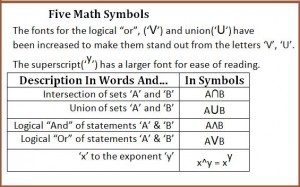Our reader’s question is: “There are two sets of symbols for” connection “and” intersection. ” One is ∪ and upside down ∩, and the other is ∨ and ∧. What is the relationship between these symbols, which we sometimes call “U” and “V”?
So let’s pay attention to our Us and V and their inverted companions in relationships and intersections and logical functions.
Mathematical symbols with questions about connection and intersection
The “V” symbols in the reader’s question are ∨ and ∧, which means “Logical or” and “Logical and”. ∧ is the big Greek Lambda.
A small ^ or “peak” is available on most keyboards as “shift-6”; symbolizes the power function. It is important not to confuse ^ with ∧.
The symbol for ‘Union of sets’ is ‘∪’, while the symbol for ‘intersection of sets’ is ‘∩’.
Set theory for connection and intersection
Venn diagrams for Unia image and intersection by Mike DeHana
We use Venn diagrams to show relationships and intersections. Photo by Mike DeHaan
The approach most similar to the question concerns set theory. Let A = {a, e, i, o, u, y} and B = {a, b, c, d, e, f}.
The combination of sets “A” and “B” is a set containing unique elements contained in set “A” or set “B”, or both. In other words, “Combine all items, but discard duplicates.” A∪B = {a, b, c, d, e, f, i, o, u, y}.
The intersection of the sets “A” and “B” is a set containing unique elements of both the set “A” and the set “B”. In other words, to create an intersection, select only the elements found in both original sets that are duplicates rejected by the join operation. A∩B = {a, e}
Regarding the original question, from the point of view of set theory, the word “relationship” refers to the symbol “∪”; and the word “intersection” refers to the symbol “∩”.
Math symbols can be confusing! Photo of JRS
Our reader’s question also concerned ‘V’ and ‘upside down’ ‘V’, ‘Λ’ or Lambda. They are used in mathematical logic.
Let the statement A = “All men are mammals.” Let B = “All mammals are humans.” Let C = “Some birds may fly under certain conditions.” Both “A” and “C” are true statements, but “B” is false.
Let “X” and “Y” represent all possible true or false statements.
In mathematics, logic “X and Y” or “XΛY” is true only if both “X” and “Y” are true.
However, “X or Y” or “X∨Y” is false only if both “X” and “Y” are false. “X∨Y” is true if “X” or “Y” is true, which includes a situation where both “X” and “Y” are true.
From the sample instructions “A∨B”, “A∨C” and “B∨C” are true. However, both “AΛB” and “BΛC” are false. Only “AΛC” is true because each of the statements “A” and “C” is true.
Computer programming with “And” and “Or”
Depending on the programming language, “X and Y” may be represented as “X && Y” instead of “XΛY”. Similarly, “X or Y” may be shown as “X || Y “instead of” X∨Y “.
Exponentiation with the Caret symbol
The carriage symbol “^” may be confused with lambda “Λ”. However, it usually represents the exponentiation operation. For example, 2 ^ 3 = 2 * 2 * 2 = 8.
When writing on paper or when the word processor supports superscript the exponent of the interpretation is displayed as superscript. See the picture above.
Summary of mathematical symbols for the intersection and union and and and Or
In the theory of multiplication, intersection and unification are marked with the symbols “∩” and “”. In mathematical logic, the operations “and” and “or” are marked with the symbols “Λ” and “V”.
The union of the collections, ‘A∪B’, can be seen as covering all elements of ‘A’ as well as elements of ‘B’; but that would not be “i” (“Λ”) of mathematical logic.
The intersection of the sets “A∩B” has even less to do with the logical operation “or” (“∨”).
Other areas of mathematics may use these symbols in different ways, but these interpretations are most directly relevant to the reader’s question.
References:
Wolfram Mathematica Documentation. Intersection; Union; And; Or. (2012). Accessed July 26, 2012.
Wood, Alan. Symbol font – Unicode alternatives for Greek and special characters in HTML. (1997-2010). Accessed July 26, 2012.

































GARY says
Thank you for this article. I don’t remember this topic when I was in high school. My daughter asked me the symbol and I don’t know anything about it and saw this article. It’s of big help, and very brief but concise explanation 👍
S=s,q,u,a,r,e u V=a,e,i,o,u
There are times I wished I’d gotten more into physics or mathematics. Both can be fascinating. But both have their moments I am so-o-o glad I’m not involved with. This topic is one of the latter for me. Every once in a while I say to myself, “Let’s see if I can’t develop a different perspective on *this* topic.” But after looking into it I say, “I was right the first time.” I’m glad there are others out there who love the things I don’t.
Nice article eliminated all my confusion.
given: A={10,11,12}
B={1,3,5,7,9,11}
C={4,5,6,7,8,9,10,11}
ask: (AxB)xC
pls. answer….
What if A squared u B squared?
can anyone help me on this?
set A = {1 2 3 4 }
set B = {5 6 7 8}
i want c++ logic for A union B
thank you for your help in advance…..:p
Pls.hurry
Mike,
You want to include in your discussion regarding union and intersection truth tables using binary {1,0} representation for and and or. More conducive for computer math and logic.
Allen
Excellent article. What if I’m using interval notation with the union symbol “U”. For example, (-2, 0] U [2, 3). If I rewrite this into inequality notation, do I join the two inequality statements with the word “or” or the word “and”. This has stumped me for a while now as I want to use “and”, but I’m not sure if that is correct.